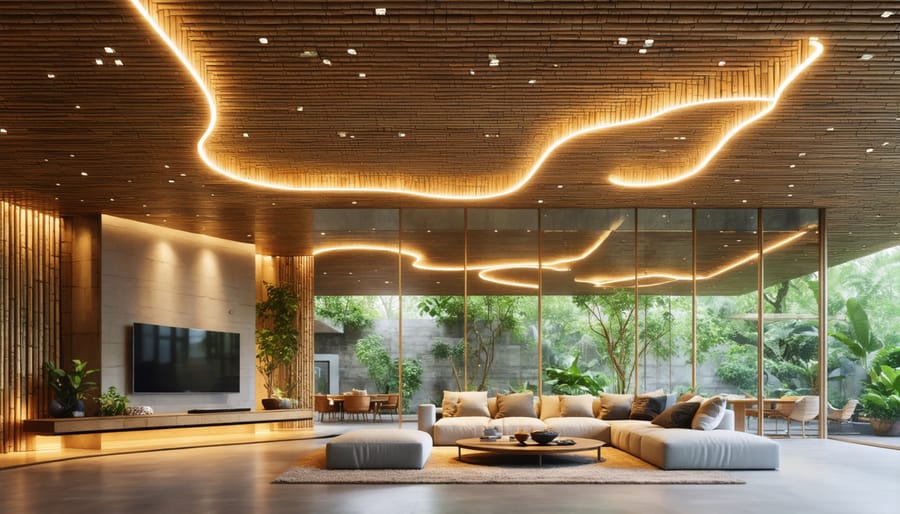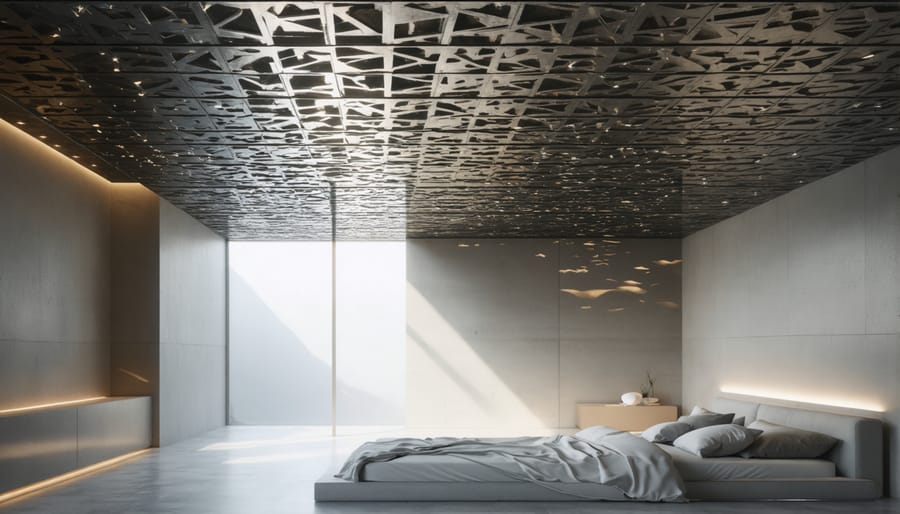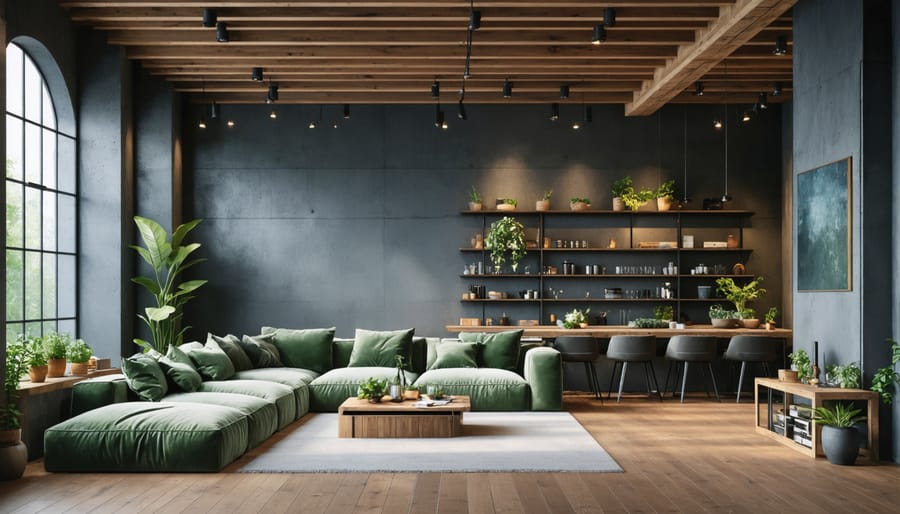
Transform Your Space: Modern Ceiling Designs That Make Rooms Feel Larger
Transform your living space into a masterpiece of modern design by reimagining the untapped potential above. Today’s innovative interiors start with stunning ceiling designs that merge smart technology with architectural brilliance. LED-integrated floating panels create dynamic lighting zones while maintaining clean sight lines. Sculptural elements and three-dimensional textures break away from flat, mundane surfaces to add visual intrigue and personality to any room. Smart home integration enables voice-controlled ambient lighting and climate management, transforming ceilings into functional command centers for modern living.
The evolution of interior design has shifted dramatically upward, with ceilings emerging as the new frontier for creative expression. No longer confined to white expanses dotted with basic light fixtures, these often-overlooked surfaces now serve as blank canvases for architectural innovation. From sustainable bamboo installations to geometric metal frameworks, today’s ceiling treatments combine aesthetic appeal with practical functionality, creating spaces that feel both larger and more intimately connected to their inhabitants.
Beyond White Paint: Modern Ceiling Materials
Sustainable Wood and Bamboo Panels
Sustainable wood and bamboo panels offer an eco-conscious approach to ceiling design while adding natural warmth and texture to your space. These materials are rapidly renewable, making them an environmentally responsible choice for modern interiors. Bamboo, in particular, grows incredibly fast and can be harvested every 3-5 years, compared to decades for traditional hardwoods.
Installation is straightforward, with most panels featuring tongue-and-groove systems that click together seamlessly. For DIY enthusiasts, pre-finished panels eliminate the need for post-installation treatment, while unfinished options allow for custom staining to match your décor. Consider using reclaimed wood panels for an authentic vintage look with an even smaller environmental footprint.
To maximize sustainability, look for FSC-certified wood products and bamboo sourced from responsible manufacturers. These panels work exceptionally well with LED lighting systems and can be installed with minimal waste. For spaces with humidity concerns, many manufacturers offer treated options that resist warping and maintain their beauty for years to come.
Remember to acclimate your panels to your room’s environment for 48-72 hours before installation to prevent gaps or buckling later on.

Metal and Glass Elements
Metal and glass elements bring a sophisticated, contemporary edge to interior spaces while creating stunning visual effects. Brushed aluminum strips, copper accents, and chrome fixtures can transform ordinary rooms into modern masterpieces. When strategically placed, metallic finishes reflect light and add depth, making spaces appear larger and more dynamic.
Glass installations, particularly in the form of skylights and partition walls, introduce natural light while maintaining an open feel. Consider incorporating frosted glass panels for privacy without sacrificing brightness, or experiment with textured glass features that create interesting shadow patterns throughout the day.
For a truly dramatic statement, combine metal and glass in suspended ceiling features. Hanging metal frames with glass inserts create an artistic overhead display, while LED-integrated glass panels bordered by metallic trim offer both aesthetics and functionality. These elements work particularly well in entryways, dining areas, and commercial spaces where visual impact is paramount.
Recent innovations include smart glass that changes opacity on demand and ultra-thin metallic films that can be applied to existing surfaces. For DIY enthusiasts, removable metallic tiles and stick-on mirror panels offer an accessible way to experiment with these materials without permanent commitment. When incorporating these elements, remember that less is often more – strategic placement of metal and glass features can create maximum impact without overwhelming the space.
Smart Lighting Integration

LED Strip Lighting Techniques
LED strip lighting has revolutionized ceiling design, offering endless possibilities for creating stunning visual effects and ambient lighting solutions. These flexible, energy-efficient strips can transform any ceiling into a dynamic focal point while providing practical illumination.
For a modern touch, consider installing LED strips in cove lighting arrangements, where the strips are hidden behind crown molding to create a soft, floating effect. This technique works particularly well in living rooms and master bedrooms, casting a gentle upward glow that makes spaces feel larger and more inviting.
Another popular application is the creation of geometric patterns using LED strips. By installing the strips in straight lines or angular designs, you can add architectural interest to otherwise plain ceilings. For maximum impact, consider using RGB LED strips that allow you to change colors and create different moods for various occasions.
Drop ceilings offer excellent opportunities for LED integration. Installing strips around the perimeter of dropped panels creates the illusion of floating ceiling elements, while strategic placement between panels can define distinct zones in open-plan spaces.
For those interested in smart home integration, many LED strip systems now come with Wi-Fi connectivity and app control. This allows you to adjust brightness levels, change colors, and create automated lighting schedules from your smartphone. When installing LED strips, always ensure proper diffusion to avoid visible hot spots and maintain a clean, professional look.
Smart Controls and Automation
Today’s innovative interiors seamlessly blend technology with design, and ceiling lighting leads this revolution. Modern smart lighting solutions offer unprecedented control over your home’s ambiance through smartphone apps or voice commands.
Imagine walking into your living room and saying, “Movie time,” and watching as your lights automatically dim to the perfect viewing level. Or having your bedroom lights gradually brighten in the morning, mimicking natural sunrise for a gentler wake-up experience. These aren’t futuristic concepts – they’re available now and surprisingly easy to install.
The key components typically include smart bulbs, wireless controllers, and a central hub that connects everything to your home network. Many systems allow you to create custom scenes for different activities, schedule lighting changes throughout the day, and even sync with other smart home devices like thermostats and security systems.
Energy efficiency is another major benefit. Motion sensors can automatically turn lights off in empty rooms, while brightness adjusters ensure you’re using only the light you need. Some systems even learn your habits over time, automatically adjusting to optimize both comfort and energy savings.
For those concerned about installation, many modern smart lighting systems are designed for DIY setup, requiring minimal technical knowledge. Most can be installed using existing wiring, making the upgrade process straightforward and cost-effective.
Architectural Elements That Pop

Exposed Beams and Trusses
Exposed beams and trusses have evolved from purely structural elements to striking design features that add character and depth to any space. Whether you’re working with original architectural elements or planning to install decorative ones, these features can transform an ordinary room into a stunning showcase of industrial-chic design.
For authentic wooden beams, consider stripping away old paint or varnish to reveal the natural grain patterns. A light sanding and clear sealant can protect while maintaining that coveted raw appearance. If your ceiling height permits, adding recessed lighting between beams creates dramatic shadows and highlights the architectural details.
Don’t have original beams? Faux wooden or lightweight polyurethane options offer the same visual impact without structural concerns. These can be installed as a weekend DIY project, complete with realistic wood textures and custom staining options. For a modern twist, consider painting exposed trusses in bold colors or metallic finishes to create an artistic focal point.
Smart integration is key – install track lighting along beams for adjustable illumination, or use the trusses to conceal wiring for speakers and smart home devices. In commercial spaces, exposed mechanical systems between trusses can create an engaging industrial aesthetic when properly coordinated with the overall design scheme.
Remember to maintain proportion – in rooms with lower ceilings, opt for slimmer beams or partial exposure to avoid overwhelming the space. For high ceilings, chunky beams or complex truss systems can help create a more intimate atmosphere while adding architectural interest.
3D Textured Panels
3D textured panels represent one of the most exciting trends in modern interior design, offering a perfect blend of visual interest and architectural sophistication. These panels transform flat surfaces into dynamic focal points, creating depth and dimension that traditional creative wall treatments simply can’t match.
Available in various materials like PVC, MDF, and bamboo composite, these panels come in countless patterns – from geometric designs to organic waves. Installation is surprisingly straightforward: most panels feature interlocking systems or can be mounted using construction adhesive and finishing nails. For best results, ensure your surface is clean, dry, and level before installation.
The versatility of 3D panels extends beyond walls – they’re equally striking on ceilings or as room dividers. Some innovative options include:
– Light-reactive panels that create shifting shadows throughout the day
– Sound-absorbing varieties perfect for home theaters or office spaces
– Moisture-resistant panels suitable for bathroom installations
– Paintable options that allow for custom color matching
When selecting panels, consider the room’s lighting, as directional lighting can dramatically enhance the three-dimensional effect. For DIY installation, start from the center of your wall and work outward, using a level to maintain straight lines. Most panels can be easily cut with a utility knife or saw, making them adaptable to various space configurations.
DIY-Friendly Ceiling Updates
Weekend Paint Techniques
Transform your walls with these weekend-friendly creative paint techniques that deliver stunning results without breaking the bank. Start with color washing, a simple method that creates a soft, watercolor effect by applying a translucent glaze over your base coat using a damp cloth. For more texture, try rag rolling – just bunch up a clean cloth and roll it through the wet glaze to create an elegant, dimensional pattern.
Want something more dramatic? Experiment with sponging, using natural sea sponges to dab on layers of paint in complementary colors. This technique works wonderfully in bathrooms and accent walls, creating depth and visual interest. For a modern twist, try color blocking with painter’s tape to create clean geometric patterns. The key is using high-quality tape and ensuring crisp edges by removing it while the paint is still slightly wet.
Don’t forget about metallic effects – use pearl or metallic glazes over solid colors to add sophistication to any room. Apply with a specialty brush in crosshatch patterns for the most professional finish. These techniques can typically be completed in a weekend, making them perfect for busy homeowners looking to refresh their space without a major time commitment.
Remember to always test your chosen technique on a sample board first, and work in small sections to maintain consistent results throughout your project.
Easy-Install Ceiling Tiles
Transform your ceiling with modern, easy-install tiles that combine style with practicality. Today’s ceiling tiles come in an impressive array of designs, from sleek metallics to natural wood looks, and they’re engineered for simple DIY installation.
Start by measuring your ceiling space and adding 10% extra for cuts and mistakes. Look for tiles with tongue-and-groove or clip-in systems, which eliminate the need for complicated mounting hardware. Popular options include lightweight PVC tiles, moisture-resistant vinyl, and eco-friendly bamboo panels.
For the installation, you’ll need basic tools: a measuring tape, utility knife, and a level. Most modern ceiling tiles can be installed directly over existing drywall or popcorn ceiling using a grid system or adhesive mounting. Many manufacturers now offer peel-and-stick options that make installation as simple as applying a large sticker.
Consider tiles with built-in LED lighting channels or acoustic properties to add functionality to your space. Some innovative options even include antimicrobial coatings or air-purifying properties, perfect for bedrooms and home offices.
Remember to acclimate your tiles to room temperature for 24 hours before installation, and always work with a partner when mounting overhead. With the right preparation and materials, you can completely renovate your ceiling in a weekend, creating a fresh, modern look that adds value to your home.
Transform your living space by embracing innovative ceiling designs that reflect your unique style and vision. From sleek minimalist approaches to bold architectural statements, the possibilities for ceiling transformation are endless. We’ve explored various techniques, materials, and technologies that can elevate your interior design from ordinary to extraordinary.
Remember that successful ceiling innovation doesn’t always require complex renovations or substantial budgets. Start small with lighting upgrades or decorative elements, then gradually work your way up to more ambitious projects as your confidence grows. Consider incorporating smart technology for added functionality, or experiment with eco-friendly materials to create a sustainable and modern aesthetic.
Whether you’re a homeowner looking to increase property value, a designer seeking fresh inspiration, or a DIY enthusiast ready for your next project, the key is to balance creativity with practicality. Focus on designs that complement your existing décor while pushing boundaries just enough to create impact.
Take the first step today by assessing your space and identifying areas where ceiling innovations could make the most difference. Consider factors like natural light, room function, and architectural features. Don’t be afraid to mix different techniques or materials to create something truly unique.
With proper planning and execution, your ceiling transformation can become the cornerstone of an innovative interior that inspires and delights for years to come.
